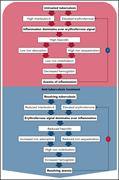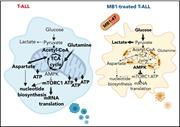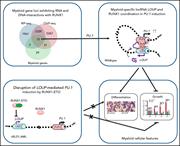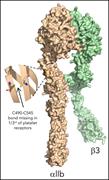Issue Archive
Table of Contents
BLOOD COMMENTARIES
CLINICAL TRIALS AND OBSERVATIONS
Iron homeostasis during anemia of inflammation: a prospective study of patients with tuberculosis
Clinical Trials & Observations
Cercamondi and colleagues meticulously detail the changes in iron homeostasis before and after treatment for tuberculosis. Initial inflammatory signaling by interleukin-6 (IL6) induces hepcidin, inhibiting gastrointestinal iron absorption. This is counterbalanced by elevated levels of erythroferrone (ERFE), which induces erythropoiesis. Upon treatment, ERFE remains elevated while IL6 and hepcidin fall, leading to increased iron absorption and concomitant reticulocytosis. These results suggest that iron repletion should be reserved for patients who do not recover after treatment.
GENE THERAPY
Long-term outcomes after gene therapy for adenosine deaminase severe combined immune deficiency
Clinical Trials & Observations
Reinhardt et al present a long-term follow-up of 10 patients who received autologous gene-corrected stem cells for adenosine deaminase (ADA)–deficient severe combined immune deficiency. All but one patient recovered sufficient immune function to prevent infections without enzyme replacement therapy. The gammaretroviral vector used has been supplanted by recent vectors to reduce risk of genotoxicity; interestingly, although these patients have insertions at proto-oncogene sites, they have not developed secondary malignancies, unlike other recipients of similar vector gene therapy.
LYMPHOID NEOPLASIA
A novel and highly effective mitochondrial uncoupling drug in T-cell leukemia
T-cell acute lymphoblastic leukemia (T-ALL) is associated with high rates of relapse, and novel therapies are needed. da Silva-Diz and colleagues describe preclinical studies of a novel mitochondrial uncoupling compound in T-ALL cell lines and in human T-ALL patient-derived xenograft models, demonstrating both cytostatic and cytotoxic effects on tumor cells. This study suggests a critical role for mitochondrial oxidative phosphorylation in T-ALL that provides a novel pathway which can be exploited for therapy.
MYELOID NEOPLASIA
Myeloid lncRNA LOUP mediates opposing regulatory effects of RUNX1 and RUNX1-ETO in t(8;21) AML
Two companion articles highlight the complex cell type–specific regulation of the expression of the master myeloid regulator PU.1. Trinh et al report that a long noncoding RNA, LOUP, induces PU.1 transcription by linking the RUNX1 transcription factor to the PU.1 enhancer and promoter, forming an active chromatin loop; induction is disrupted in t(8;21) translocation leukemia, where binding of the RUNX1-ETO fusion protein decreases chromatin accessibility. In the other article, van der Kouwe et al demonstrate further complexity, reporting that PU.1 transcription is negatively regulated by an antisense RNA that is also induced by RUNX1. PU.1 transcription thus reflects competitive interaction of the enhancer with the sense and antisense promoter; RUNX1-ETO activates the antisense promoter at the expense of the sense promoter, decreasing PU.1 expression.
Core-binding factor leukemia hijacks the T-cell–prone PU.1 antisense promoter
THROMBOSIS AND HEMOSTASIS
An alternate covalent form of platelet αIIbβ3 integrin that resides in focal adhesions and has altered function
Pijning et al report the novel observation that the platelet aIIbβ3 integrin receptor occurs in 2 different covalent forms. Onethird of the molecules lack 1 disulfide bond, thereby changing the distribution of the receptor in the platelet membrane, its signaling properties, and its rate of uptake into clathrin-coated pits.
LETTER TO BLOOD
BLOOD WORK
-
Cover Image
Cover Image
![issue cover]()
Ablation of the αIIb C490-C545 disulfide bond restricts distribution of αIIbβ3 integrin to focal adhesions. Cells were seeded onto fibrinogen, stained for β3 integrin (green), vinculin (red), and nuclei (blue), and imaged by confocal microscopy. See the article by Pijning et al on page 1359.
- PDF Icon Front MatterFront Matter
- PDF Icon Table of ContentsTable of Contents
- PDF Icon Editorial BoardEditorial Board
Advertisement intended for health care professionals
Email alerts
Advertisement intended for health care professionals










TB or not TB? Soft pity opens the iron gates
Clinical Trials & Observations